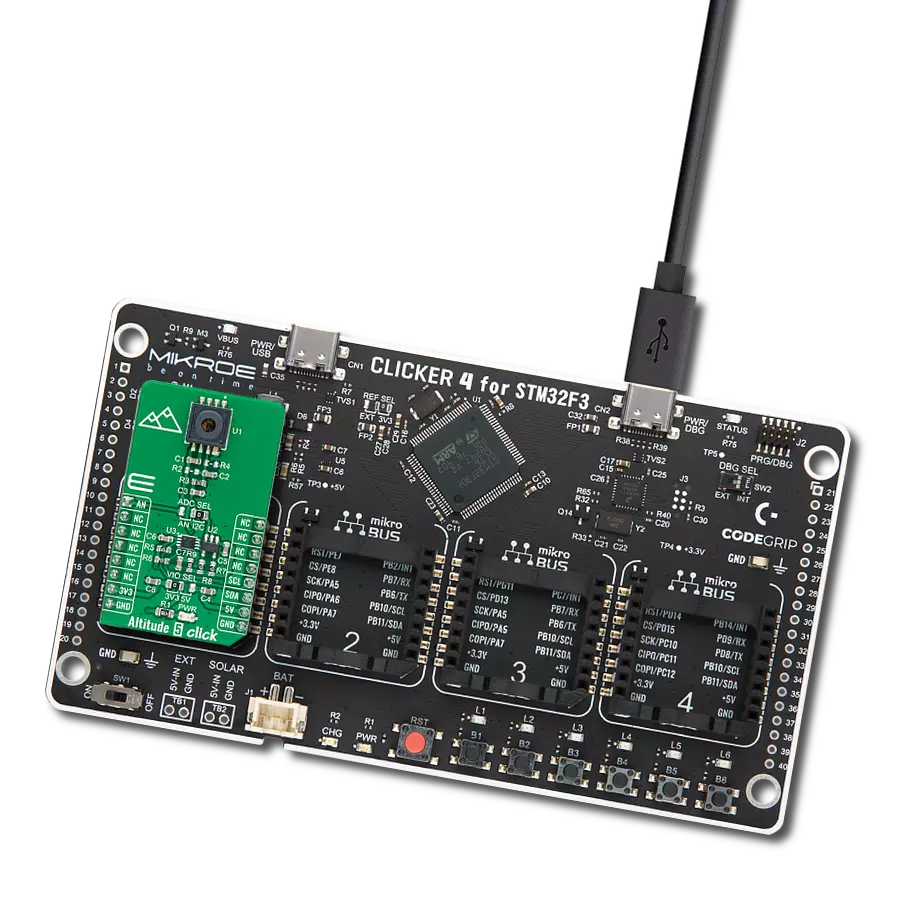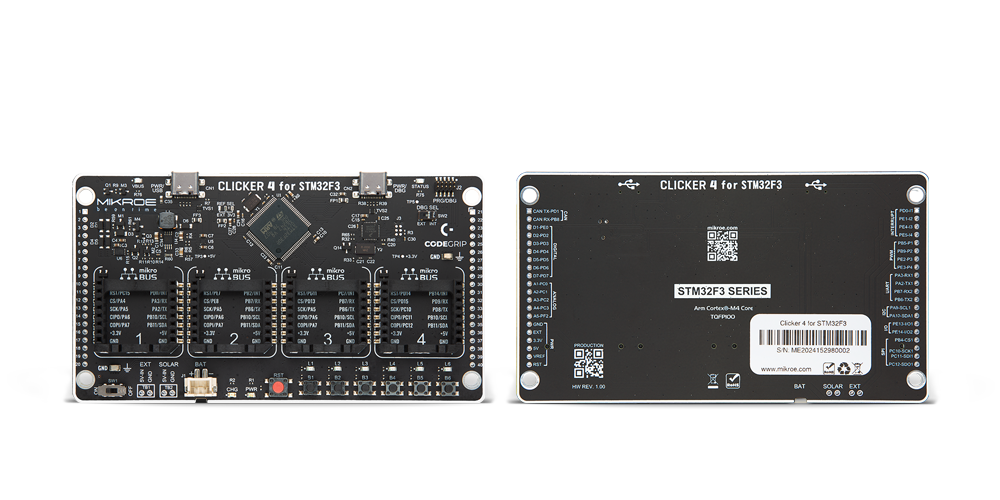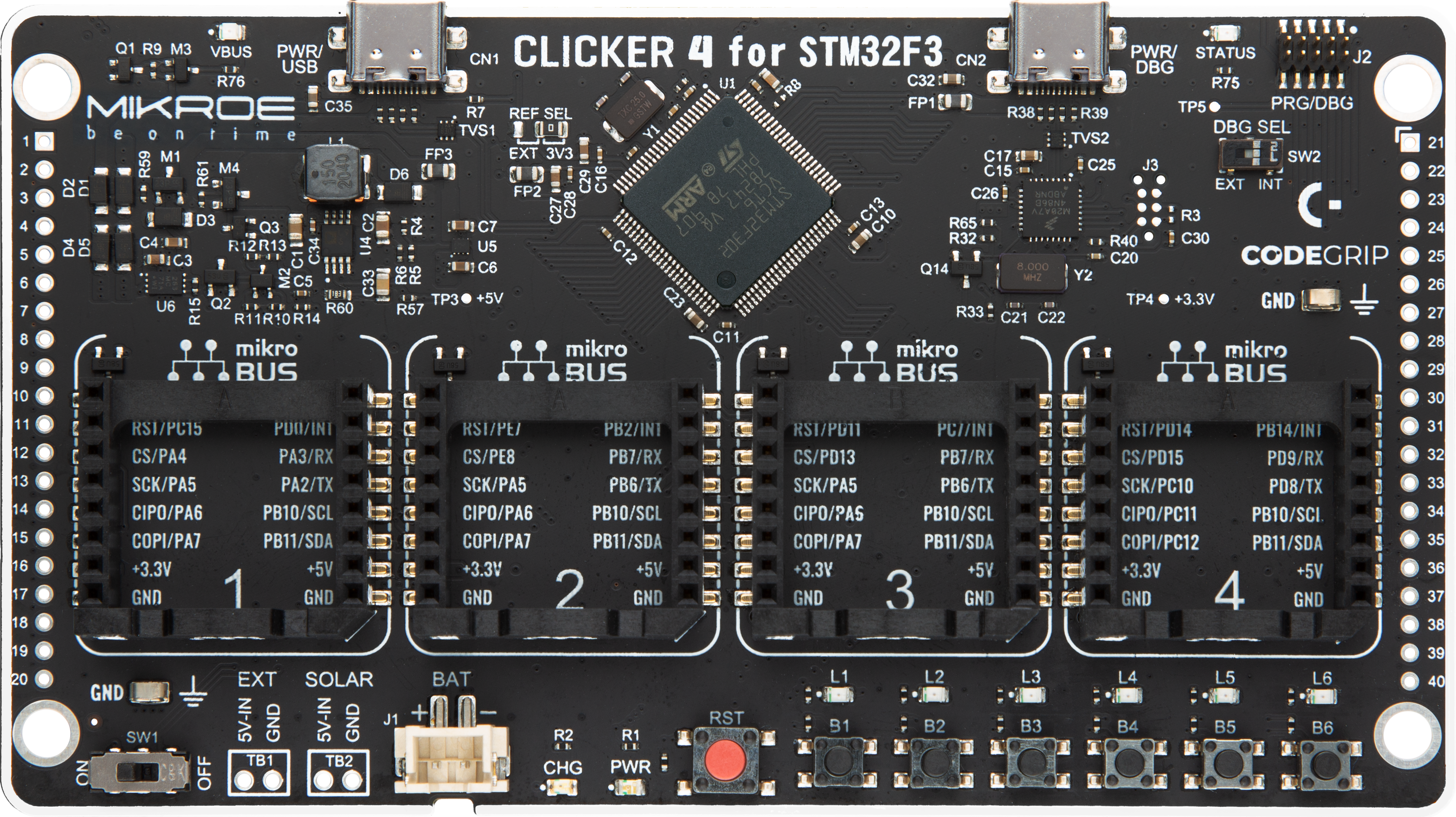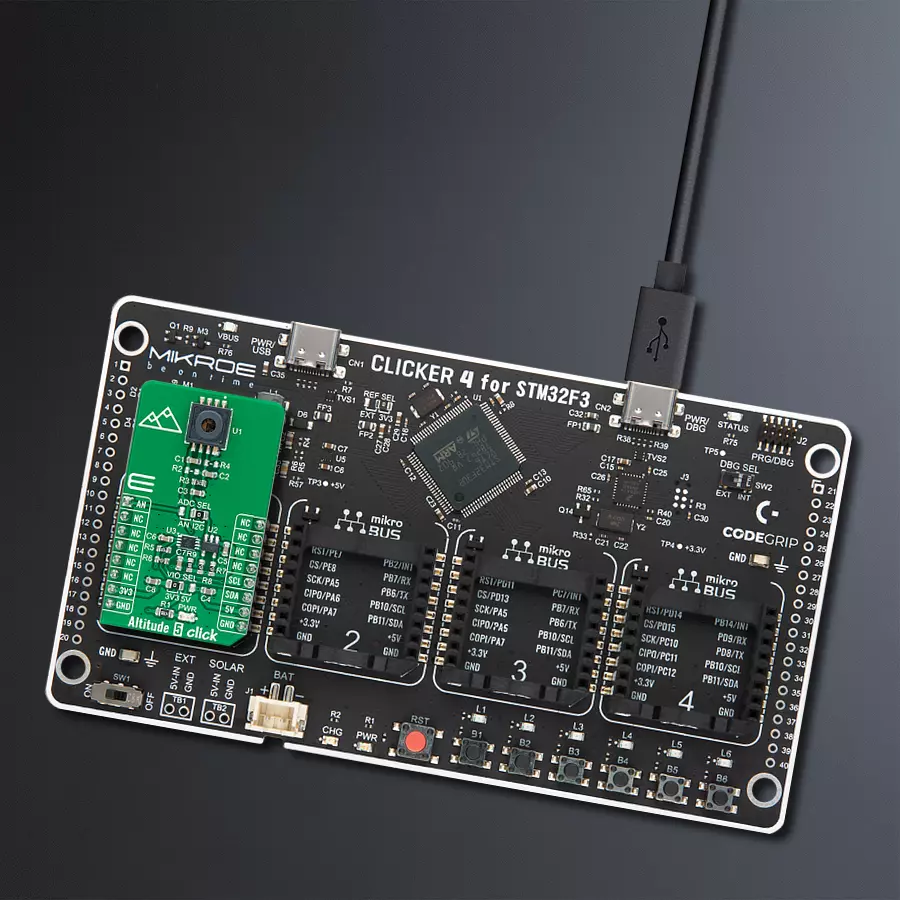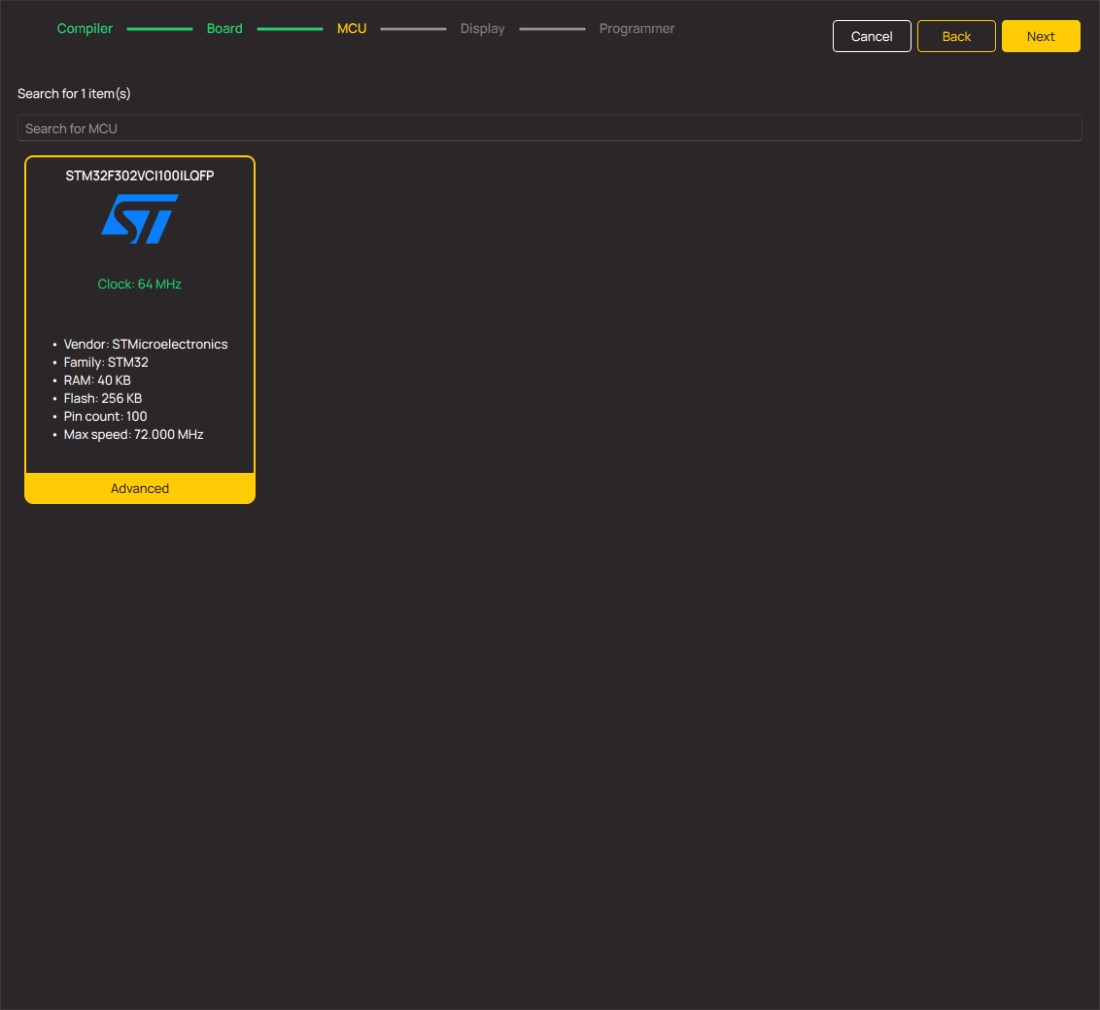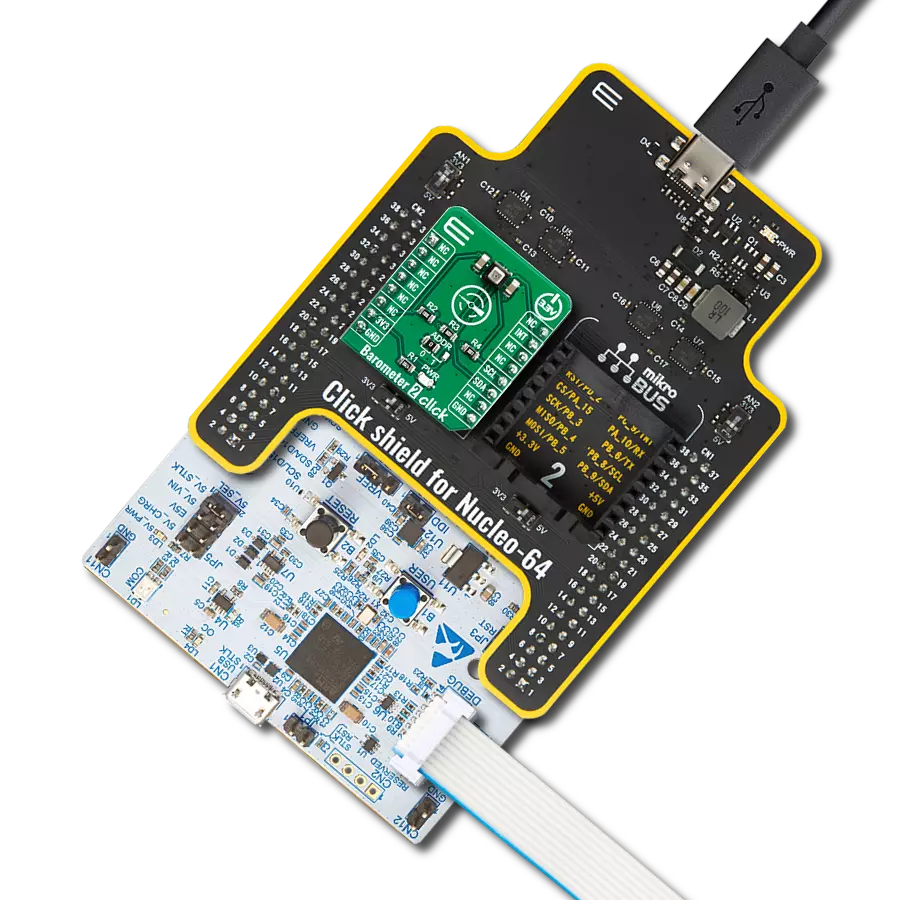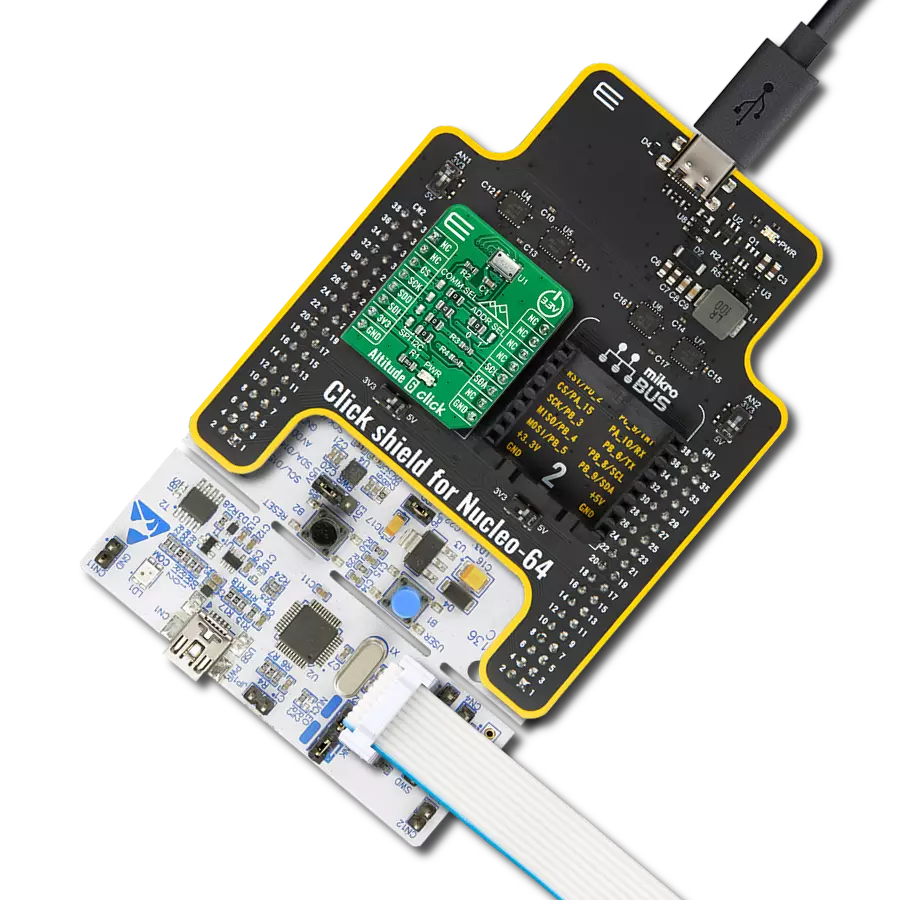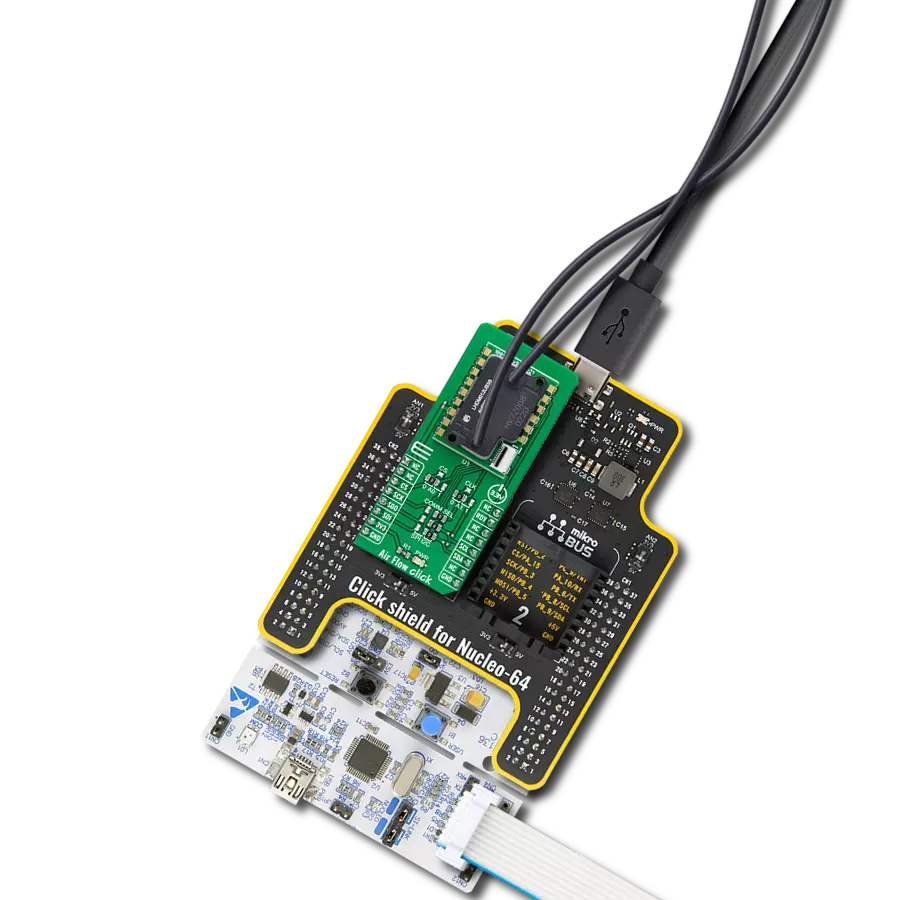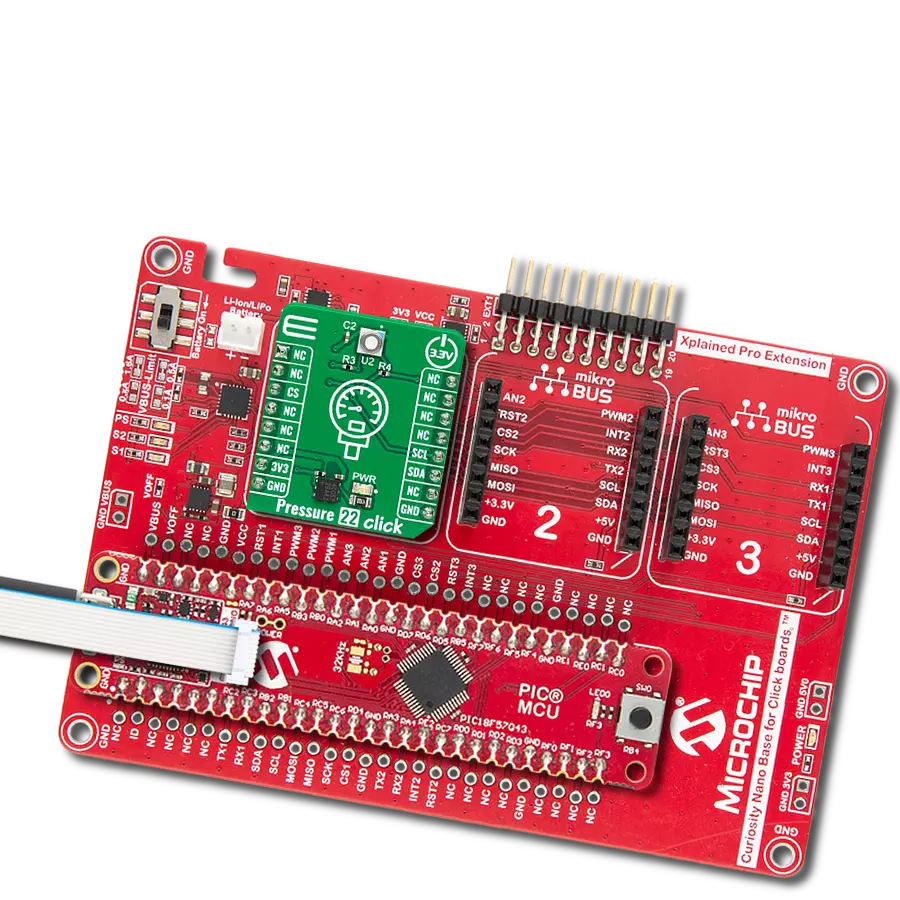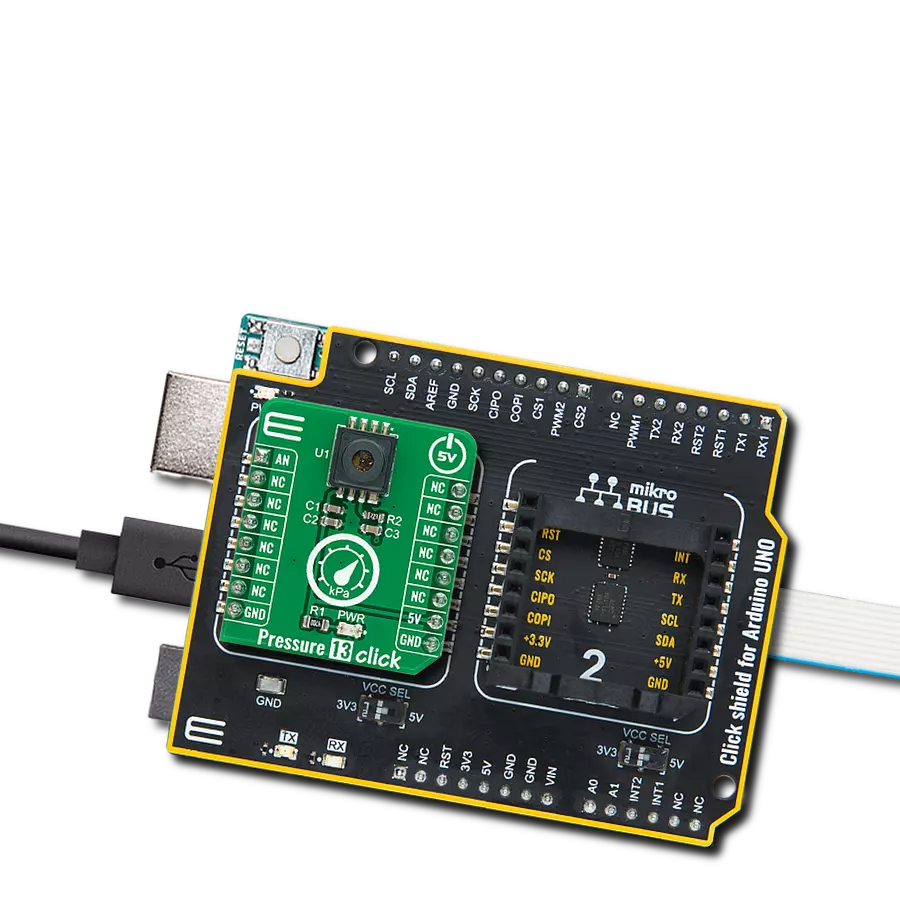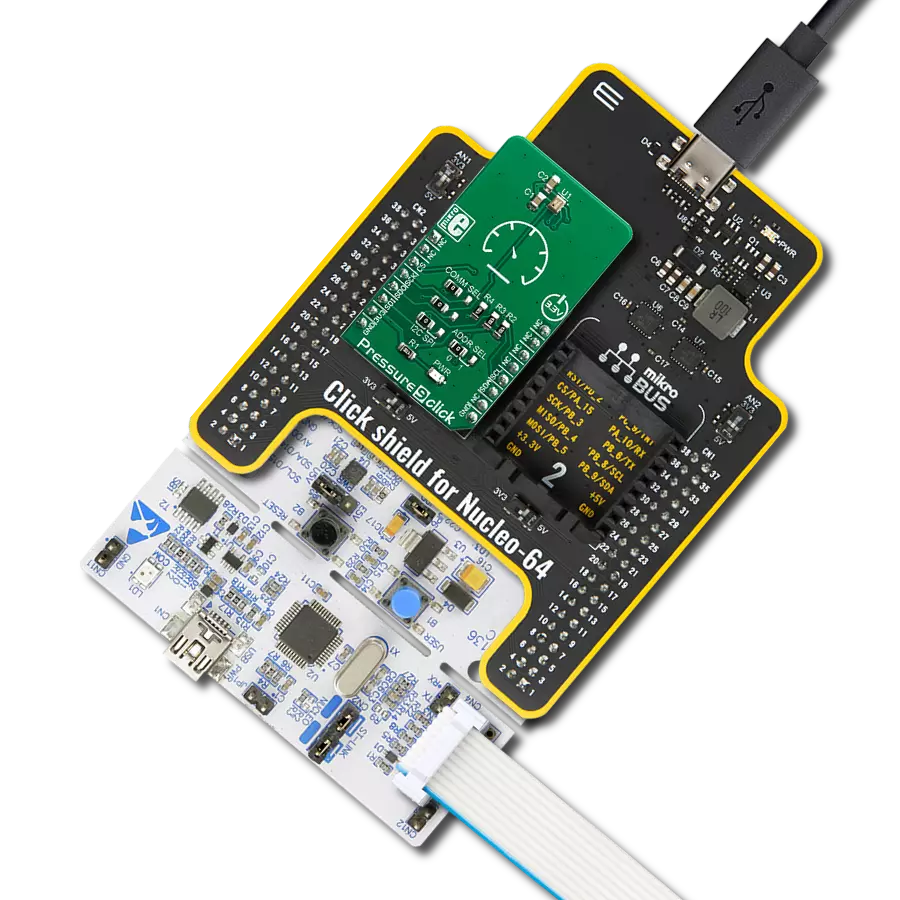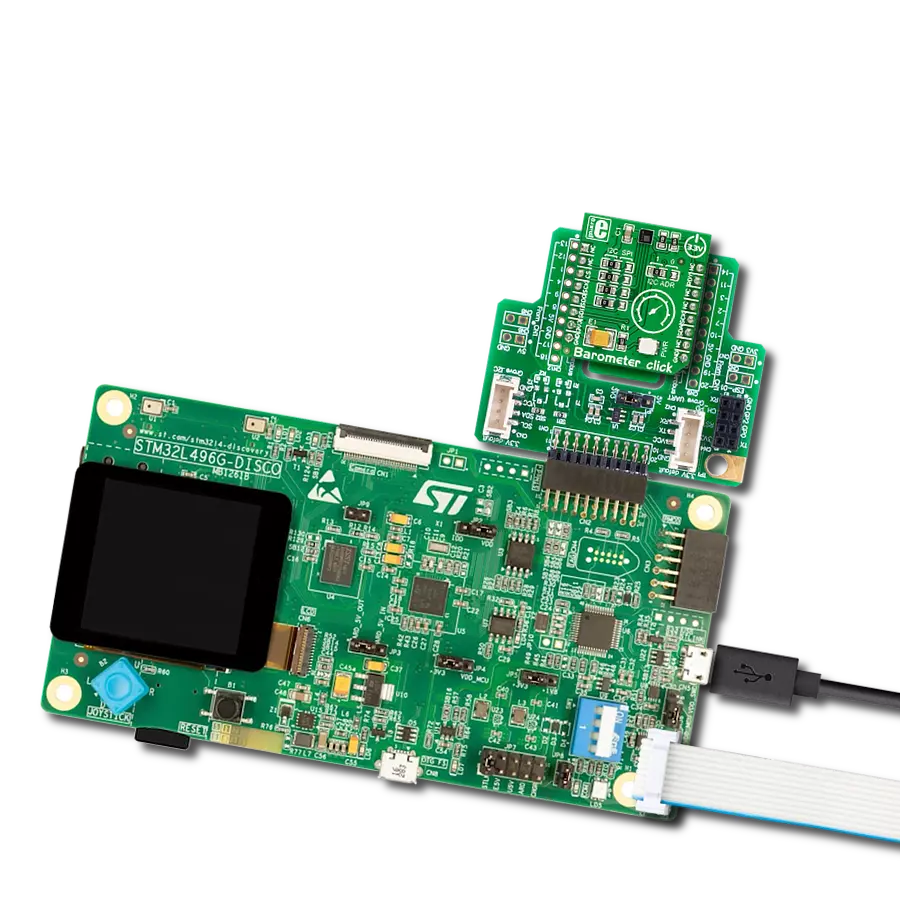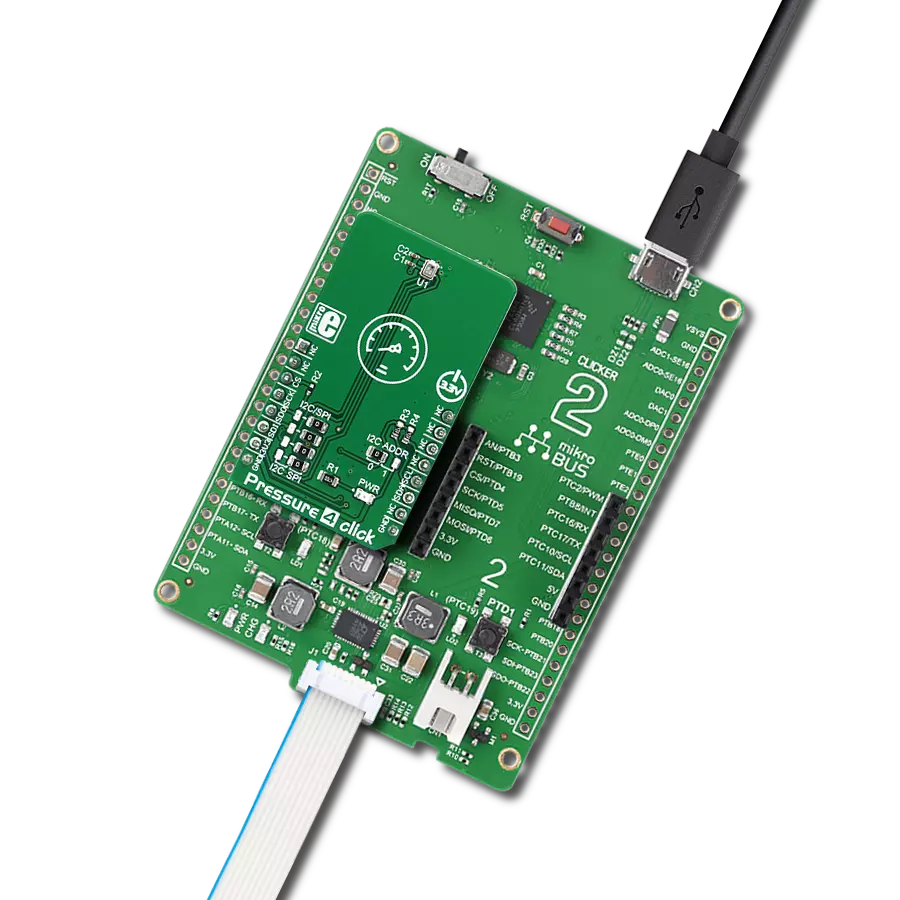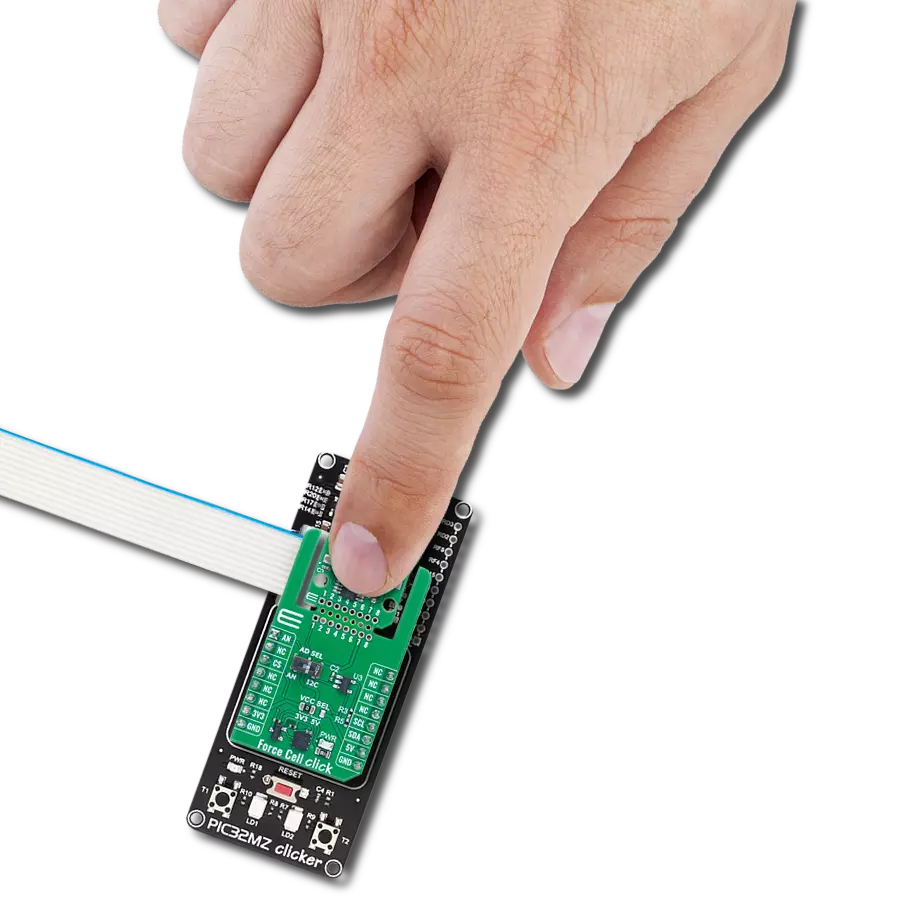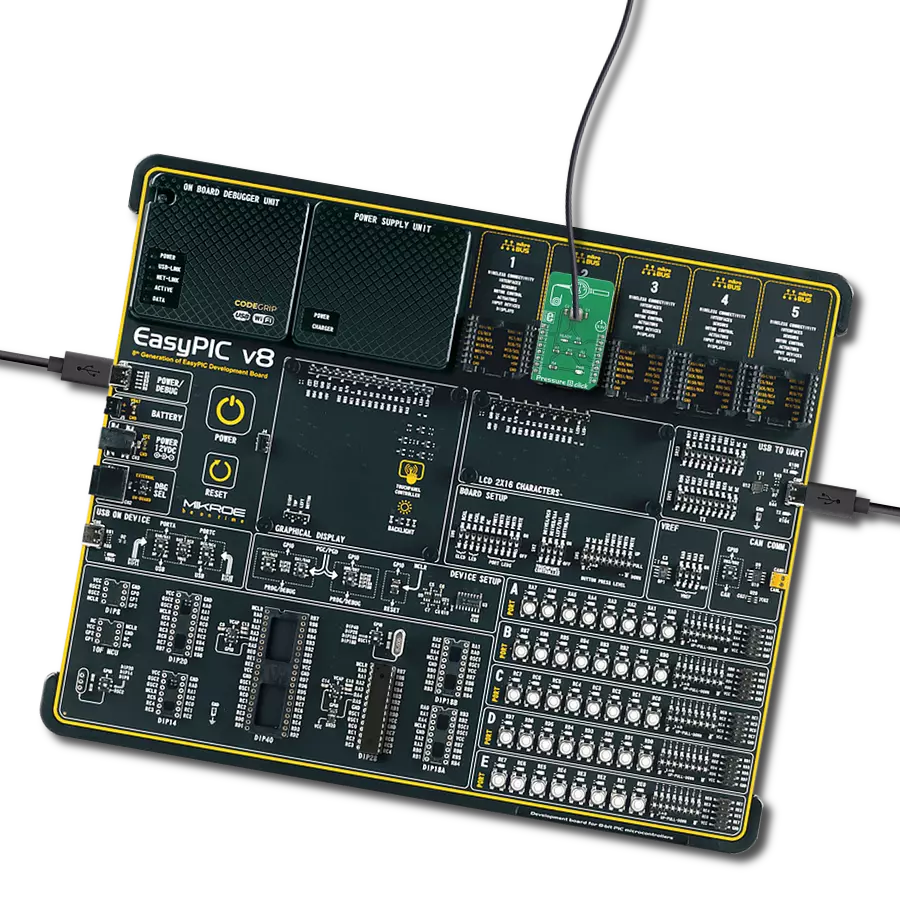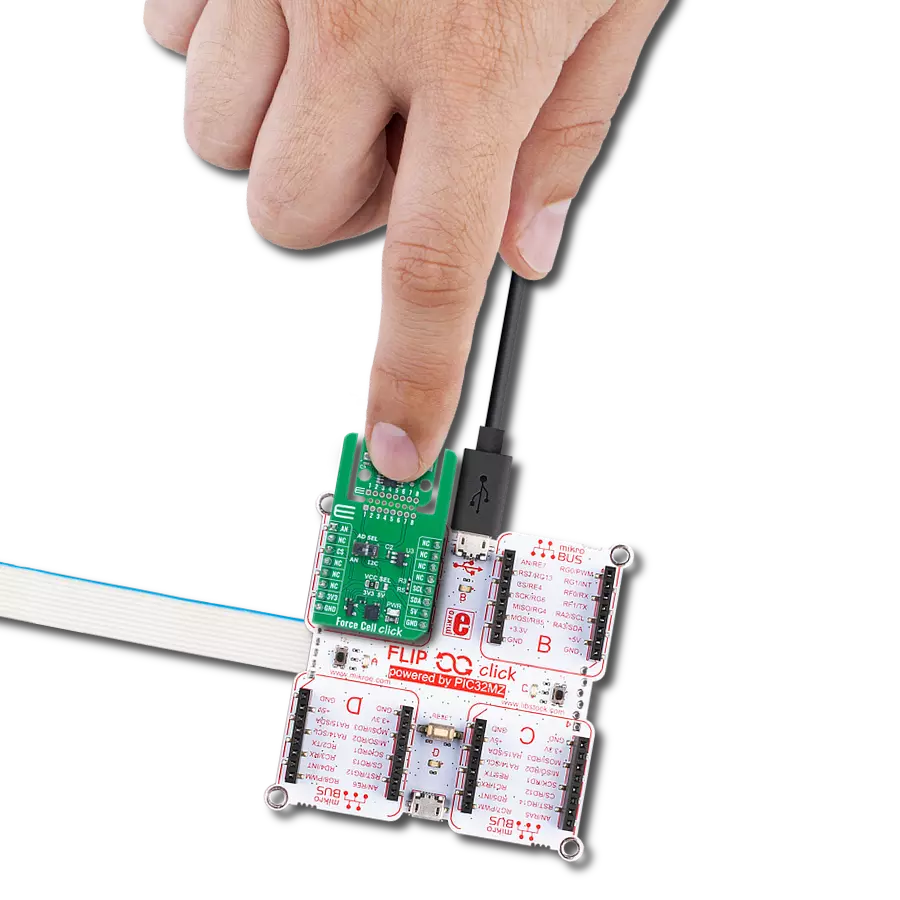A key instrument for measuring vertical distance, our altimeters are designed for accurate altitude tracking in various fields
A
A
Hardware Overview
How does it work?
Altitude 5 Click is based on the KP236, a high-resolution analog barometric air pressure sensor based on a capacitive principle from Infineon. The KP236 surface is micro-machined with a monolithic integrated signal conditioning circuit implemented in BiCMOS technology that can measure pressure in a range from 40kPa up to 115kPa with an accuracy of ±1Pa over a wide operating temperature range at the industry’s lowest power. The KP236 is primarily developed for measuring barometric air pressure but can also be used in other application fields. The pressure is detected by an array of capacitive surface micro-machined sensor cells. The sensor cell output is amplified, temperature-compensated, and linearized to obtain an output voltage proportional
to the applied pressure. The transfer function for linearization is computed in the digital part of the sensor using a third-order polynomial calculation. The sensor converts pressure into an analog output signal; more precisely, the user can process the output signal in analog or digital form. The analog output voltage of the KP236 can be converted to a digital value using MCP3221, a successive approximation A/D converter with a 12-bit resolution from Microchip, using a 2-wire I2C compatible interface, or can be sent directly to an analog pin of the mikroBUS™ socket labeled as AN. Selection can be performed by onboard SMD jumper labeled ADC SEL to an appropriate position marked as AN and I2C. Using MCP3221 and I2C interface, data transfers at 100kbit/s
in the Standard and 400kbit/s in the Fast Mode Since the sensor for operation requires a 5V logic voltage level only, this Click board™ also features the PCA9306 voltage-level translator from Texas Instruments. The I2C interface bus lines are routed to the dual bidirectional voltage-level translator, allowing this Click board™ to work properly with both 3.3V and 5V MCUs. This Click board™ can operate with either 3.3V or 5V logic voltage levels selected via the VIO SEL jumper. This way, both 3.3V and 5V capable MCUs can use the communication lines properly. Also, this Click board™ comes equipped with a library containing easy-to-use functions and an example code that can be used as a reference for further development.
Features overview
Development board
Clicker 4 for STM32F3 is a compact development board designed as a complete solution, you can use it to quickly build your own gadgets with unique functionalities. Featuring a STM32F302VCT6, four mikroBUS™ sockets for Click boards™ connectivity, power managment, and more, it represents a perfect solution for the rapid development of many different types of applications. At its core, there is a STM32F302VCT6 MCU, a powerful microcontroller by STMicroelectronics, based on the high-
performance Arm® Cortex®-M4 32-bit processor core operating at up to 168 MHz frequency. It provides sufficient processing power for the most demanding tasks, allowing Clicker 4 to adapt to any specific application requirements. Besides two 1x20 pin headers, four improved mikroBUS™ sockets represent the most distinctive connectivity feature, allowing access to a huge base of Click boards™, growing on a daily basis. Each section of Clicker 4 is clearly marked, offering an intuitive and clean interface. This makes working with the development
board much simpler and thus, faster. The usability of Clicker 4 doesn’t end with its ability to accelerate the prototyping and application development stages: it is designed as a complete solution which can be implemented directly into any project, with no additional hardware modifications required. Four mounting holes [4.2mm/0.165”] at all four corners allow simple installation by using mounting screws. For most applications, a nice stylish casing is all that is needed to turn the Clicker 4 development board into a fully functional, custom design.
Microcontroller Overview
MCU Card / MCU
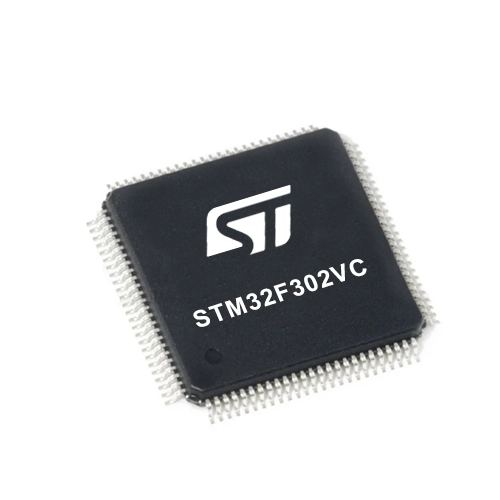
Architecture
ARM Cortex-M4
MCU Memory (KB)
256
Silicon Vendor
STMicroelectronics
Pin count
100
RAM (Bytes)
40960
Used MCU Pins
mikroBUS™ mapper
Take a closer look
Click board™ Schematic

Step by step
Project assembly
Software Support
Library Description
This library contains API for Altitude 5 Click driver.
Key functions:
altitude5_get_altitude- Altitude 5 get altitude functionaltitude5_get_pressure- Altitude 5 get pressure functionaltitude5_get_adc_voltage- Altitude 5 get ADC voltage function
Open Source
Code example
The complete application code and a ready-to-use project are available through the NECTO Studio Package Manager for direct installation in the NECTO Studio. The application code can also be found on the MIKROE GitHub account.
/*!
* @file main.c
* @brief Altitude5 Click example
*
* # Description
* This library contains API for Altitude 5 Click driver.
* The demo application reads ADC value, calculate pressure and altitude.
*
* The demo application is composed of two sections :
*
* ## Application Init
* Initializes I2C or analog driver and log UART.
* After driver initialization the app set default settings.
*
* ## Application Task
* This is an example that demonstrates the use of the Altitude 5 Click board™.
* In this example, we read ADC values and
* display the Pressure ( mBar ) and Altitude ( m ) data.
* Results are being sent to the Usart Terminal where you can track their changes.
*
* @author Nenad Filipovic
*
*/
#include "board.h"
#include "log.h"
#include "altitude5.h"
static altitude5_t altitude5;
static log_t logger;
void application_init ( void )
{
log_cfg_t log_cfg; /**< Logger config object. */
altitude5_cfg_t altitude5_cfg; /**< Click config object. */
/**
* Logger initialization.
* Default baud rate: 115200
* Default log level: LOG_LEVEL_DEBUG
* @note If USB_UART_RX and USB_UART_TX
* are defined as HAL_PIN_NC, you will
* need to define them manually for log to work.
* See @b LOG_MAP_USB_UART macro definition for detailed explanation.
*/
LOG_MAP_USB_UART( log_cfg );
log_init( &logger, &log_cfg );
log_info( &logger, " Application Init " );
// Click initialization.
altitude5_cfg_setup( &altitude5_cfg );
ALTITUDE5_MAP_MIKROBUS( altitude5_cfg, MIKROBUS_1 );
err_t init_flag = altitude5_init( &altitude5, &altitude5_cfg );
if ( I2C_MASTER_ERROR == init_flag )
{
log_error( &logger, " Application Init Error. " );
log_info( &logger, " Please, run program again... " );
for ( ; ; );
}
altitude5_default_cfg ( &altitude5 );
log_info( &logger, " Application Task " );
log_printf( &logger, "----------------------------\r\n" );
Delay_ms ( 100 );
}
void application_task ( void )
{
static float pressure;
static float altitude;
altitude5_get_pressure( &altitude5, &pressure );
log_printf( &logger, " Pressure : %.2f mBar \r\n", pressure );
Delay_ms ( 100 );
altitude5_get_altitude( &altitude5, &altitude );
log_printf( &logger, " Altitude : %.2f m \r\n", altitude );
log_printf( &logger, "----------------------------\r\n" );
Delay_ms ( 1000 );
}
int main ( void )
{
/* Do not remove this line or clock might not be set correctly. */
#ifdef PREINIT_SUPPORTED
preinit();
#endif
application_init( );
for ( ; ; )
{
application_task( );
}
return 0;
}
// ------------------------------------------------------------------------ END
Additional Support
Resources
Category:Pressure
